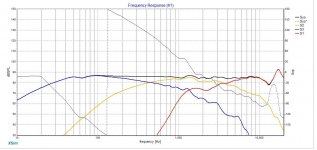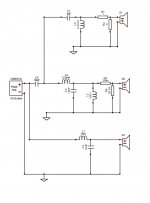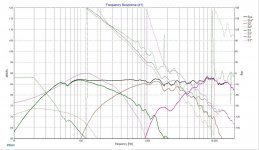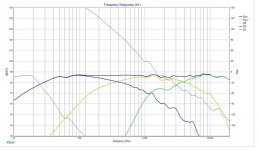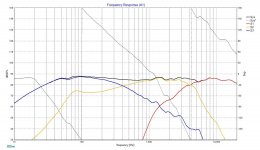Hi,
After playing a while in xsim I came up with this;
This is my first attempt at any sort of crossover so I'd appreciate all comments on what I've knackered and what I have failed to consider
Below are the files for the TMW units...
Thanks,
After playing a while in xsim I came up with this;
This is my first attempt at any sort of crossover so I'd appreciate all comments on what I've knackered and what I have failed to consider
Below are the files for the TMW units...
Thanks,
Attachments
Hi. What does your phase response look like?
No idea TBH...
If you're familiar with xsim tell me how to find it and I'll post.
cheers
Sorry, it's there on your FR plot... 
Is this in an enclosure of sorts? What I'm actually asking about is the phase response for each driver. I'm not familiar with xsim, but if your phase response is doing weird things, your off-axis performance will not be good, and this causes a lot of quality issues. I'm sure there's a button there to show individual response for phase? Aligning phase in the crossover is very important, as far as I understand.
Is this in an enclosure of sorts? What I'm actually asking about is the phase response for each driver. I'm not familiar with xsim, but if your phase response is doing weird things, your off-axis performance will not be good, and this causes a lot of quality issues. I'm sure there's a button there to show individual response for phase? Aligning phase in the crossover is very important, as far as I understand.
Excellent.  Now I think it's best for the experts to provide their wisdom.
Now I think it's best for the experts to provide their wisdom.
The only thing I can say for sure is that your tweeter might distort. Try to get rid of that bump from about 1.3kHz to 2.2kHz. You could also try to add a second series capacitor after the inductor, before the L-pad, to get a higher order filter so that you're further down at 1.5kHz.
Otherwise, it's looking nice!
The only thing I can say for sure is that your tweeter might distort. Try to get rid of that bump from about 1.3kHz to 2.2kHz. You could also try to add a second series capacitor after the inductor, before the L-pad, to get a higher order filter so that you're further down at 1.5kHz.
Otherwise, it's looking nice!
Excellent.... Try to get rid of that bump from about 1.3kHz to 2.2kHz...
Wow! I wasn't expecting that
I played with the values a little more after posting earlier. I found this was the best I could come up with...
By the way, this is with a different tweeter... a Dayton ND28F-6.
Attachments
I think let the guys who know crossovers better than me give their advice. I'm no expert - just a small amount of experience. The phase of each driver is important information.
HaHa... you're no expert,
Many thanks Mrcloc
It is difficult to say whether this is good or not but it appears to be a good start. You have only information from single driver measurements so there may be issues that can be partially compensated for, and these might be possible after listening and deciding how much they can and can't be compensated. The question of whether phase should be matched is also beyond this level of simulation. Then there is the question of whether the response should be flat in your room.
It is difficult to say whether this is good or not but it appears to be a good start. You have only information from single driver measurements so there may be issues that can be partially compensated for, and these might be possible after listening and deciding how much they can and can't be compensated. The question of whether phase should be matched is also beyond this level of simulation. Then there is the question of whether the response should be flat in your room.
Thanks Allen,
I wasn't expecting to find myself with anything close to a usable xo TBH as this is my first attempt so it comes as a surprise. But if there is consensus that this creation has some merit or degree of promise then it's worthwhile building. It very well may serve as a learning aid as I experiment.
I was hoping that the learned folk here would be able to determine what more this might need to be viable. Is there some more info I could provide perhaps? I haven't factored in any BSC and re room shaping, well I can't really comment. I'm merely happy to make a start, listen and then lean on the knowledge and experience of others here for further direction.
I hope that makes sense.
It does. I think you should give it a try. To be fair, it might not be the way I'd do it but maybe that doesn't matterI hope that makes sense.
Hi, as noted in earlier posts you only have 10dB of attenuation at tweeter resonance. This will likely cause distortion in the tweeter as you turn the power up.
I would recomend reworking the tweeter section with an extra capacitor so it is a third order function. It should be able to get better attenuation of the tweeter resonance. You might find this pulls the phase in a bit as well. Try to get the phase lines to overlap through the crossover region this way the drivers will add in phase.
Regards,
Andrew
I would recomend reworking the tweeter section with an extra capacitor so it is a third order function. It should be able to get better attenuation of the tweeter resonance. You might find this pulls the phase in a bit as well. Try to get the phase lines to overlap through the crossover region this way the drivers will add in phase.
Regards,
Andrew
For a sim of how this might play off-axis due to driver phase matching, you can try this version of Xsim3D (still in beta). It lets you specify the position of each driver relative to the other drivers, and also can include off-axis simulation of each driver -- use a set of on and off-axis FRD files (if you have them) or you can simulate drivers' off-axis by assuming they are "pistons" based on active diameter with on-axis response shape superimposed. Dayton audio provides off-axis data file sets for some of its drivers, at least out to 45 degrees, and Omnimic has a neat facility for quickly gathering a series of off-axis response curves.
I think you'll see that driver positioning typically has WAY more to do with the off-axis performance than does the phase matching between the drivers. And the baffle effects (not simulated in XSim3D, at least not yet) will also have a lot to do with off-axis performance. For a depressing look at reality, turn on the floor and ceiling reflection effects in the geometric model and see why the "on-axis" response alone doesn't really much define how the speaker is going to sound.
Index of /Xsim/BetaTest
I think you'll see that driver positioning typically has WAY more to do with the off-axis performance than does the phase matching between the drivers. And the baffle effects (not simulated in XSim3D, at least not yet) will also have a lot to do with off-axis performance. For a depressing look at reality, turn on the floor and ceiling reflection effects in the geometric model and see why the "on-axis" response alone doesn't really much define how the speaker is going to sound.
Index of /Xsim/BetaTest
For a depressing look at reality, turn on the floor and ceiling reflection effects
I believe (but really can't say for sure) that this is where the d'Appolito configuration shines.
I believe (but really can't say for sure) that this is where the d'Appolito configuration shines.
easy to check, model it. Actually, there's a simple model of that in the examples.
edit: beta version bug just fixed, re-uploaded..... there was a crash with some originally non-3D files loaded
Last edited:
Thanks for the replies everyone.
So from what I'm taking from the posts above, 2 issues needed addressing based on the FR plot and driver curves;
1. Phase of drivers (not that I understand this completely )
)
2. Attenuation at the tweeter resonance freq
I have *fiddled* with a different circuit and have come up with this...
Appreciate the comments and direction from all.
cheers
So from what I'm taking from the posts above, 2 issues needed addressing based on the FR plot and driver curves;
1. Phase of drivers (not that I understand this completely
2. Attenuation at the tweeter resonance freq
I have *fiddled* with a different circuit and have come up with this...
Appreciate the comments and direction from all.
cheers
Attachments
It's revealing, isn't itFor a depressing look at reality, turn on the floor and ceiling reflection effects
- Status
- This old topic is closed. If you want to reopen this topic, contact a moderator using the "Report Post" button.
- Home
- Loudspeakers
- Multi-Way
- 3 Way Crossover - a first attempt
